Imagine the internet as an immense library. Instead of books, this library is filled with billions of websites. When you seek specific information, you need a method to sift through these billions to find the most relevant pages. This is the role of search engines like Google. They catalog all online content and deliver results that align with your search. But how do they determine which pages to show at the top? This is where the role of search engine optimization, or SEO, becomes vital.
SEO is both an art and a science. It aims to enhance your website’s visibility to search engines. The process involves understanding online search behaviors, the language used in searches, and the preferred content type. By tailoring your website’s content to these elements, you boost your chances of ranking higher in search results. This, in turn, can increase your site’s traffic and visibility.
Table of Contents
Consider SEO as a collection of best practices for effective digital marketing. It focuses on making your website accessible, relevant, and engaging to both search engines and your audience. This includes refining your content, ensuring your website’s technical health, and enhancing your online reputation through links from other websites.
Why is SEO important? The data is telling. Research indicates that the first page of Google captures up to 92% of search traffic clicks. This underscores a critical point: if you’re not on the first page, you’re nearly invisible.
SEO requires ongoing effort. It’s not a one-off task but a continuous endeavor to evolve and adapt to the internet’s dynamic nature and search engine algorithms. The aim is not merely to reach the top but to maintain your position and continue drawing quality traffic to your site.
What is SEO
Search Engine Optimization (SEO) is a strategic practice that involves enhancing the visibility and ranking of a website on search engine results pages. By optimizing various elements such as content, keywords, and backlinks, SEO aims to attract organic traffic and improve the overall online presence of a website.
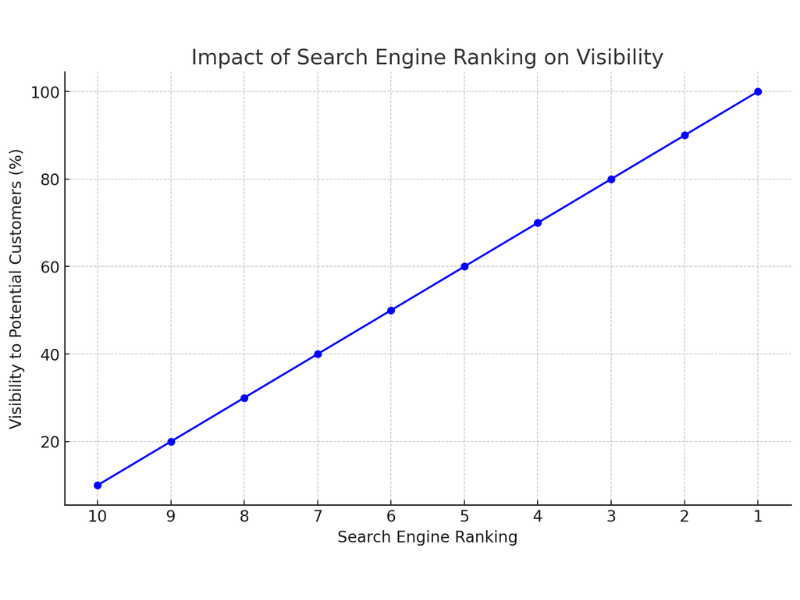
Why is SEO important?
In today’s bustling digital world, the significance of SEO unfolds like a heartfelt story, one that’s essential to the narrative of your online presence. Imagine SEO as the bridge connecting your world to those who seek what you have to offer. But why is this bridge so vital?
Visibility and Rankings: Picture SEO as your digital guiding light. When prospects embark on their search journey, you want your beacon to shine the brightest. Higher visibility in search results is akin to standing on a stage in front of an audience, eagerly waiting for what you have to say. The higher you rank, the more likely these digital explorers are to find you, pause, and listen to your story.
Web Traffic: The heart of SEO beats in its ability to draw visitors to your site. By tenderly crafting your content to align with the search engines’ wisdom, you’re not just attracting an audience; you’re engaging with souls who are actively seeking the knowledge, products, or experiences you offer. This isn’t just traffic; it’s a congregation of individuals who are more likely to connect deeply with your narrative.
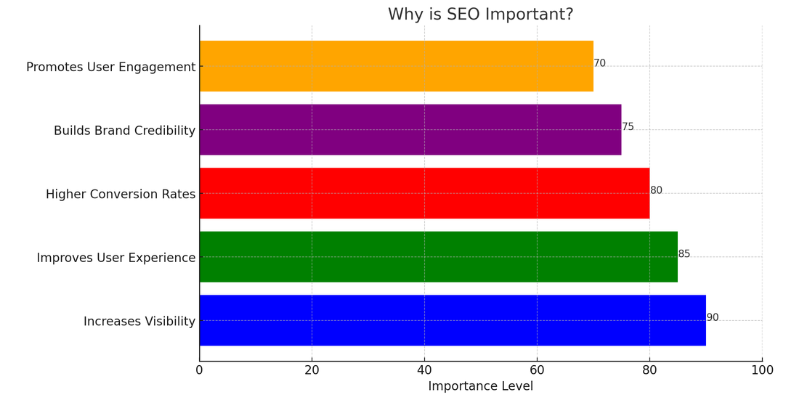
Trustworthiness and Credibility: As your site ascends the ranks in search results, it’s not just gaining clicks; it’s earning trust. The digital populace often views websites on the first page as more credible, almost like a silent nod of approval from the search engine. SEO helps lay the foundation of your site’s credibility, like a digital handshake assuring quality and trust.
User Experience: A well-optimized website speaks directly to its visitors’ hearts. It’s not just about the aesthetics; it’s about creating a space where visitors can effortlessly find answers, solutions, and inspiration. Good SEO practices ensure your site is not just a collection of pages but a haven for those who visit.
Growth: At its core, SEO is about growth—not just in numbers but in connections. It’s about reaching out through the digital expanse and inviting people into your world, where they can explore, engage, and potentially find a place that resonates with their needs and aspirations.
The Three Core Components of a Strong SEO Strategy
A successful SEO strategy stands on three pillars: technical optimization, content, and backlinks. Each plays a key role in how search engines view and rank your website. Here’s a closer look at these essential elements:
Technical Optimization
Technical SEO lays the groundwork for your strategy. It ensures search engines can crawl and index your site smoothly. Key aspects include:
- Mobile-Friendliness: With most searches now on mobile devices, a mobile-optimized site is essential. Google’s mobile-first indexing uses the mobile version of your site as the starting point for indexing.
- Site Speed: Fast-loading pages enhance the user experience and are favoured by search engines.
- Secure Sockets Layer (SSL): A secure site, indicated by an https URL, builds user trust and is preferred by search engines.
- Clean Site Structure: An organized site with a clear hierarchy aids search engines in understanding and indexing your pages.
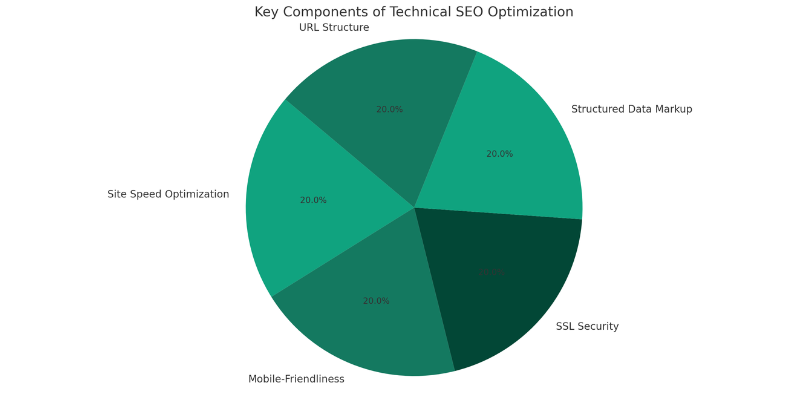
Content
Content addresses what users seek when they enter a query. The impact of your SEO efforts heavily depends on the quality and relevance of your content.
- Quality over quantity: Focus on creating content that meets your audience’s needs and answers their questions.
- Keyword Optimization: Incorporate relevant keywords naturally to help search engines grasp your content’s context.
- Engaging and Readable: Make content engaging and easy to read. Short paragraphs, bullet points, and headers improve accessibility.

Backlinks
Backlinks are inbound links from other websites. They signal to search engines the credibility and authority of your site:
- Quality over quantity: A single high-quality backlink from a reputable site is more valuable than many low-quality links.
- Natural Link Building: Gain links through quality content, outreach, and industry relationships. Avoid buying links or participating in link schemes.
- Diverse Link Profile: Seek backlinks from various sources to build your site’s authority.
Incorporating technical optimization, content, and backlinks into your SEO strategy builds a solid foundation for your website’s search engine visibility. Technical optimization makes your site accessible and user-friendly. Content draws and engages users. Backlinks enhance your site’s authority, showing search engines that your content is valuable and trustworthy.
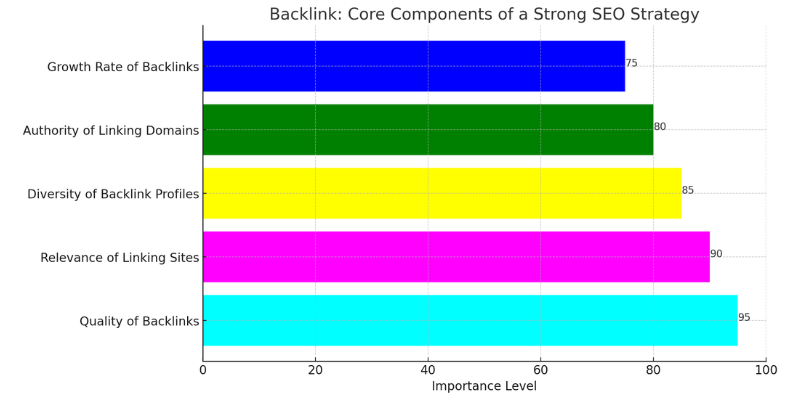
Types of SEO
In the intricate world of SEO, understanding its various facets is like exploring different paths in a vast garden, each leading to its own unique beauty. Let’s journey through the types of SEO, each with a distinct approach to harmonizing your website with the melody of search engines and the desires of your audience.
On-Page SEO
This is like tending to your garden with care, ensuring every flower and shrub (or, in this case, every web page) is nurtured to its fullest potential. It involves:
Cultivate your content with the right mix of keywords, just as a gardener would choose the right seeds.
Tending to the HTML source code of each page is akin to pruning and shaping plants to help them flourish.
Ensuring that the titles, headers, and images are like welcoming gates and signposts, guiding and delighting visitors.
Off-Page SEO
Imagine this as the reputation you build in the broader community of the internet. It’s about:
Creating connections through backlinks, similar to making friends in the neighborhood, enhances your standing and trustworthiness.
Engaging in social media, guest blogging, and brand mentions is akin to attending community events and participating in conversations that extend beyond your garden’s boundaries.
Technical SEO
This is like ensuring the infrastructure of your garden is sound, with well-maintained paths, clear signage, and secure fences. It includes:
Optimizing website speed and mobile-friendliness, making sure visitors can stroll through your garden with ease, regardless of how they arrive.
Implementing structured data will help search engines understand your garden’s layout and the treasures it holds.
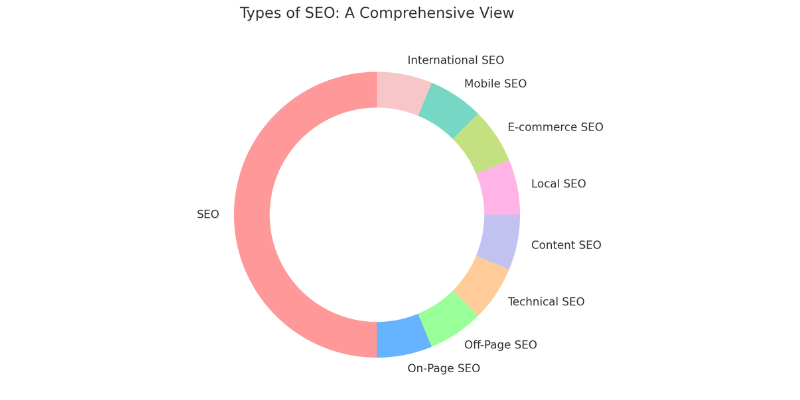
Content SEO
Here, the focus is on creating content that not only blooms beautifully but also provides nourishment and delight. It involves:
Understanding what your audience is eager to explore and crafting content that meets and exceeds their needs, much like growing a variety of plants to appeal to different tastes and preferences,.
Local SEO
For businesses with a physical presence, this is about making your garden a beloved landmark in the local community. It includes:
Tailoring your content and details to the local audience ensures that when people nearby are searching for a place to visit, your garden is a top recommendation.
E-commerce SEO
In the world of online shopping, this is about making your digital storefront inviting and easy to navigate, ensuring that each product is displayed attractively and informatively, much like a well-organized market stand.
Mobile SEO
With many visitors exploring gardens on their mobile devices, this aspect ensures that your garden is just as enchanting and accessible on a small screen as it is on a larger one.
International SEO
For gardens that welcome visitors from around the world, this means ensuring signs are multilingual, paths are clear for international visitors, and the beauty of your garden resonates across cultures.
In the realm of SEO, understanding and nurturing these various aspects is like being a skilled gardener, architect, and storyteller, all in one. Each type of SEO plays a crucial role in ensuring your digital presence not only flourishes but also becomes a sanctuary for those who discover it.
How do search engines work?
Understanding how search engines work is akin to unraveling the mysteries of a grand library. It’s a journey into understanding how countless stories and pieces of knowledge are sorted, categorized, and presented to those seeking them. Let’s gently pull back the curtain to reveal the intricate dance of search engines.
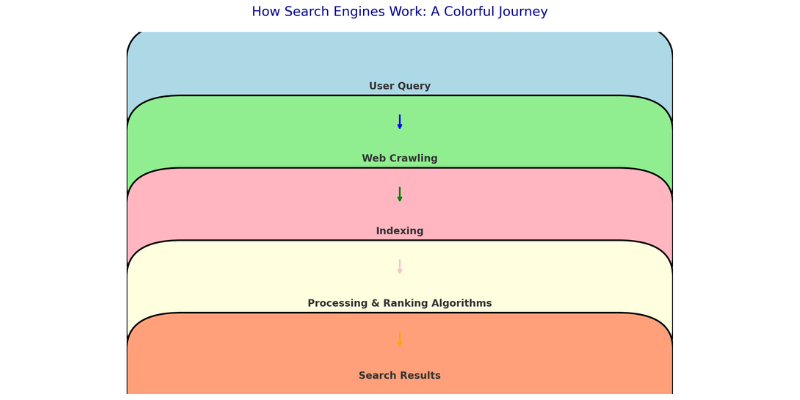
Crawling: Imagine search engines as curious explorers, traversing the vast digital landscape. These explorers, known as crawlers or spiders, embark on a quest to discover new and updated content. Like adventurers, they follow paths (links), uncovering the myriad of pages the internet offers, be it a poetic blog post, a vivid image, or an informative video.
Indexing: Once the explorers have gathered their findings, these are stored in a colossal index—a library of epic proportions. Here, every piece of content is meticulously cataloged, ready to be summoned when the right query is made. This index is the heart of the search engine, pulsing with information from all corners of the digital world.
Ranking: When someone poses a query, it’s like a quest for the perfect story or piece of wisdom. The search engine delves into its vast index to find the most relevant, informative, and helpful content. This process, known as ranking, is akin to a librarian finding the best books to answer a reader’s question. The higher the relevance of the content to the query, the higher its position on the search result page, akin to books placed on the most accessible shelf.
This entire process is guided by complex algorithms—sets of rules and criteria that the search engines use to understand, categorize, and prioritize content. These algorithms consider elements like keyword relevance, website structure, and user experience. Just as a librarian has a system to decide which books are displayed prominently, search engines use these algorithms to present the most fitting content for every search query.
Why SEO focuses on Google
In the digital world, Google reigns supreme, capturing the attention of SEO experts and website owners everywhere. This focus comes from Google’s immense market share, cutting-edge algorithms, and its role as a pioneer in online search. Let’s delve into why SEO strategies prioritize Google.
Dominant Market Share
Google’s overwhelming presence in the search engine market is the key reason SEO targets it. With more than 90% of the global market, Google is the primary choice for users searching online. This dominance means optimizing for Google can greatly increase a website’s visibility, traffic, and conversions.
Advanced Algorithms
Google is famous for its sophisticated search algorithms. These algorithms are constantly updated to better understand user searches, recognize quality content, and penalize unfair ranking manipulation. Significant updates, like Panda, Penguin, and RankBrain, aim to enhance search result quality. By adhering to Google’s guidelines, SEO professionals help ensure their sites offer valuable content, earning them higher rankings.
Role as a Trendsetter
Google leads the way in new technologies and best practices for search. It has introduced critical innovations like mobile-first indexing, HTTPS security, and schema markup. Following Google’s standards helps websites stay relevant and compatible with the most popular search engine, improving performance across all search platforms.
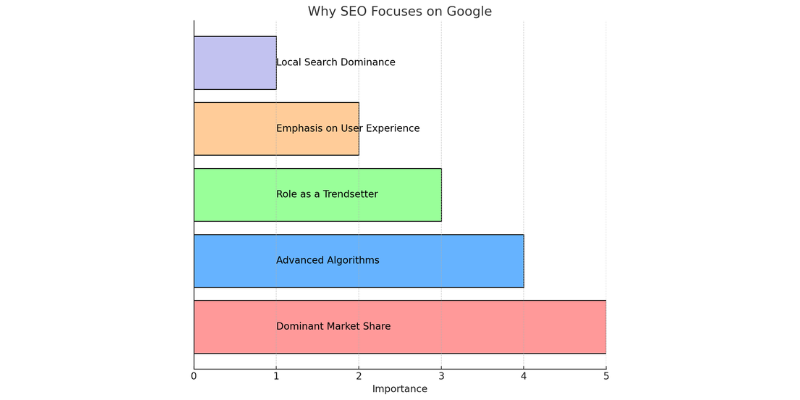
Emphasis on User Experience
Google values user experience (UX) highly, considering factors such as site speed, mobile compatibility, content quality, and engagement. Optimizing for Google encourages websites to enhance their UX, benefiting search rankings and improving visitor engagement and conversions.
Local Search Dominance
For local businesses, Google’s local search features, like Google My Business and Local Pack listings, are essential. Optimizing for Google improves visibility in local search results, driving local traffic and customers to businesses.
In summary, the strategic focus on SEO for Google is driven by its market leadership, algorithm sophistication, and pioneering role in online search. While it’s vital to recognise other search engines in an overarching SEO strategy, Google’s guidelines and algorithms often take precedence for SEO professionals aiming to boost their websites’ visibility and success.
What Google Desires
Understanding Google’s priorities is crucial for anyone aiming to enhance their website’s visibility in search rankings. Google’s mission is to offer an outstanding user experience by presenting search results that are relevant, precise, and reliable. To fulfill this mission, Google evaluates websites based on several critical factors. We will delve into the key elements Google values, providing guidance for your SEO strategy.
High-Quality Content
At the core of Google’s evaluation is content. The search engine strives to present content that answers the user’s search query with accuracy and depth. High-quality content is informative, well-researched, authentic, and adds value for the reader. Google’s algorithms, like Panda, reward superior content and penalize content of little value.
User Experience (UX)
The user experience holds significant importance for Google. Websites that are user-friendly, fast, and mobile-responsive tend to achieve higher rankings. These features contribute to a positive user experience, which Google prioritizes. Essential aspects of UX, including the structure of the site, its loading speed, and mobile compatibility, are crucial for ranking well.
Trustworthiness and Authority
Google seeks to provide results from sources that are both authoritative and trustworthy. This is particularly relevant for YMYL (Your Money or Your Life) websites, which can significantly impact users’ wellbeing, financial condition, or safety. Signals such as quality backlinks, content accuracy, clear sourcing, and the visibility of author credentials are used by Google to assess a website’s credibility.
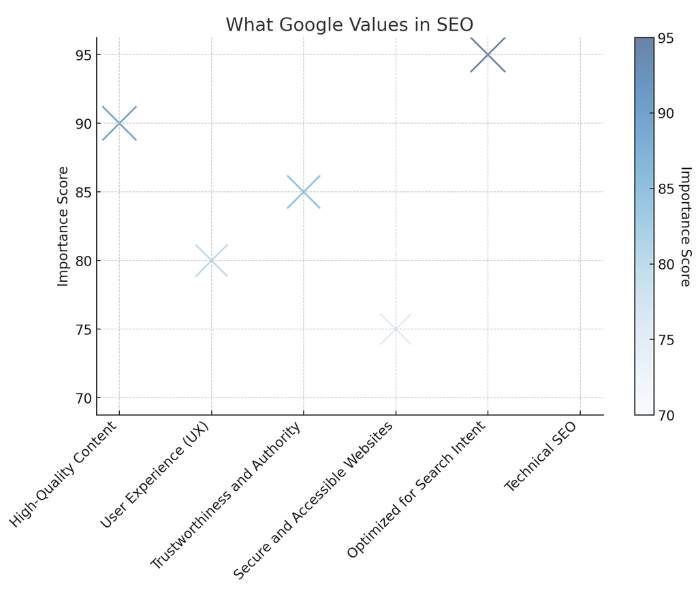
Secure and accessible websites
Google advocates for the use of HTTPS encryption to secure the user’s browsing experience. A secure website not only safeguards data exchange but also builds trust with visitors. Furthermore, a straightforward robots.txt file and a sitemap facilitate Google’s crawlers in accessing and indexing a site’s content efficiently.
Optimized for Search Intent
Google increasingly aims to align search results with the user’s intent, whether it’s seeking information, finding a location, making a transaction, or something else. Understanding the user’s goal behind a search query and tailoring content to meet those needs is essential. Websites that match their content with user intent are more likely to achieve high rankings.
Technical SEO
Technical SEO elements like schema markup, streamlined code, and structured data play a vital role in helping Google comprehend your site’s content. These technical adjustments can also lead to enhanced visibility in search results through rich snippets, improving click-through rates.
How Does Google Know How to Rank a Page?
Google’s knack for accurately ranking web pages stems from its sophisticated use of algorithms and machine learning. These systems sift through hundreds of factors, known as ranking signals. They gauge a page’s relevance, authority, and quality in response to a user’s search. Now, let’s explore how Google evaluates these signals to determine page rankings.
Crawling and Indexing
The journey begins with crawling and indexing. Google’s bots explore the web, moving from one page to another. They index the content they discover, organizing it into a vast database. This step is crucial for Google to understand what’s on the web.
Analyzing Content Relevance
After indexing a page, Google examines its content. The goal is to figure out how relevant the content is to certain search queries. This involves analyzing the topics discussed, the content’s quality, and its alignment with the searcher’s intent. Keywords are vital in this process. They help Google grasp the content’s subject matter.
Evaluating Quality and Authority
To judge a webpage’s quality and authority, Google looks at several indicators. A key factor is the number and quality of backlinks pointing to the page. Each link from a credible site is like a vote of confidence, signaling the content’s value and reliability. Other aspects, such as content length, readability, and the inclusion of authoritative references, also play a role in assessing quality.
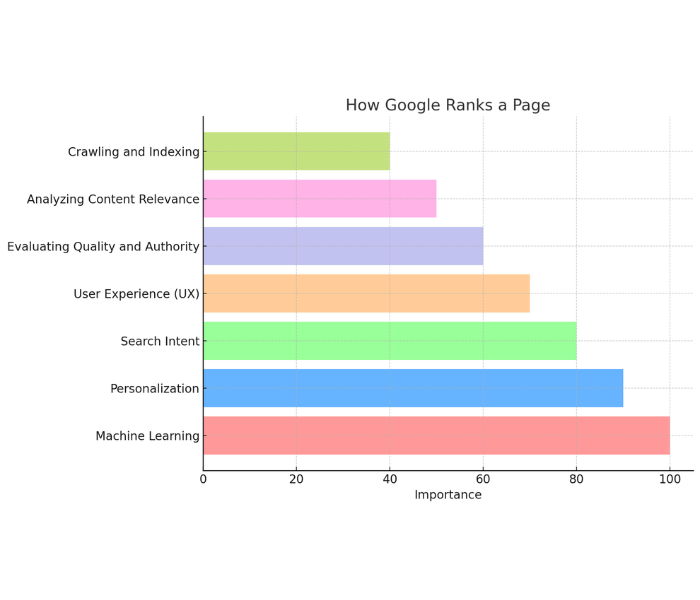
User Experience (UX)
Google evaluates how user-friendly a website is through various UX signals. It considers page load speed, mobile compatibility, and ease of navigation. Websites offering a good user experience tend to rank higher. This aligns with Google’s aim to fulfill searchers’ needs effectively.
Search Intent
Grasping the user’s search intent is vital for Google. It categorizes intent into four types: informational, navigational, transactional, and local. Google strives to align search results with the assumed intent, ensuring users find what they’re searching for.
Personalization
Google customized search results based on the user’s location, search history, and preferences. This personalization means search results can differ among users. The aim is to offer a more tailored experience that meets individual needs.
Machine Learning
Google employs machine learning algorithms, such as RankBrain, to enhance search results. RankBrain interprets search queries and user behavior nuances. This allows Google to better understand the context and intent behind searches. Consequently, it can rank pages more accurately.
Through these advanced techniques and signals, Google can determine the relevance, quality, and user experience of web pages. This process helps Google rank pages in a manner that best meets the user’s needs. As a result, the search engine makes the vast web information both accessible and useful.
The role of SEO
The role of SEO in the digital world is akin to a guide on a journey through a vast and intricate forest. It’s not just about marking the path but enriching the journey with understanding, connection, and relevance. Let’s delve into this guiding role with warmth and empathy.
Increasing Visibility and Traffic: Imagine SEO as a lantern bearer, illuminating your path in the dense forest of the internet. Its light increases your visibility, ensuring that when people search for paths that intersect with yours, it’s your trail that they find. This increase in visibility, like rays of sunlight breaking through the canopy, leads to more organic traffic—travelers who have chosen your path because it aligns with their quest.
Building Credibility and Trust: In this forest, higher paths are often deemed safer and more reliable. SEO elevates your position, building credibility and trust with your audience. As you ascend to these heights, you become a beacon of reliability and authority, a trusted guide in the eyes of those who journey through the digital wilderness.
Enhancing User Experience: SEO is not just about the destination but the journey. It involves crafting a path that is clear, enjoyable, and enriching. A well-optimized website is like a well-trodden trail, easy to navigate and rich with signposts and wonders. It’s about ensuring that every traveler who chooses your path feels welcomed, guided, and valued.
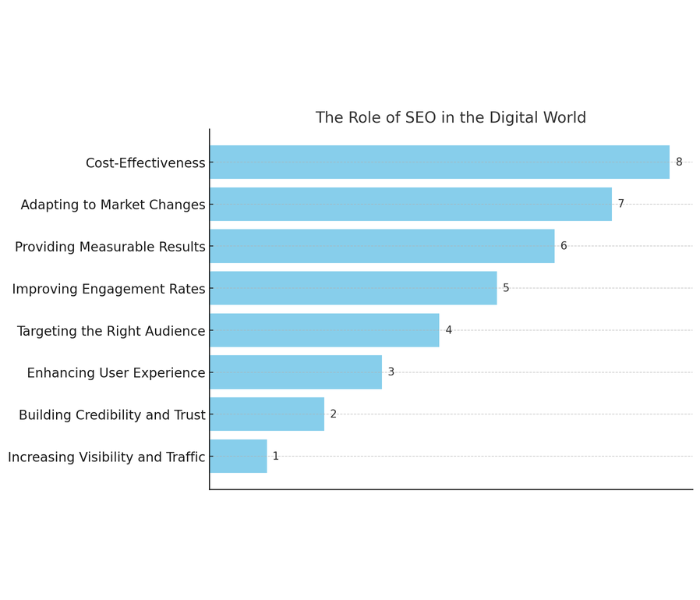
Targeting the Right Audience: Just as every traveler in the forest is on a unique journey, SEO helps you connect with those whose quests align with what you offer. Through keyword research and understanding user intent, your path is tailored to intersect with those seeking exactly what you provide, leading to more meaningful and fruitful encounters.
Improving Engagement Rates: As your path becomes more visible and inviting, engagement naturally blossoms. Travelers stop to admire the view, explore the surroundings, and engage with the journey. They leave footprints—comments, shares, and likes—signs of a journey well enjoyed and a path well chosen.
Providing Measurable Results: In the realm of SEO, every step can be tracked, every bird’s song heard. Tools like Google Analytics offer insights into the travelers on your path—where they come from, how they journey, and what they seek. This data is like a map, guiding your ongoing strategies and adjustments.
Adapting to Market Changes: The forest of the internet is ever-changing, and SEO is your compass. It guides you through shifting landscapes, new trends, and evolving paths. It’s about staying agile and responsive, ensuring your journey remains relevant and your path is true.
Cost-Effectiveness: Compared to other forms of digital marketing, SEO is like finding a naturally beautiful path in the forest, requiring less artificial construction. It’s a cost-effective way to build your presence and attract travelers, relying on the organic beauty of the landscape rather than costly embellishments.
SEO Marketing Basics
Embarking on the journey of SEO marketing is like starting a profound conversation with the world. It’s not just about the words you use; it’s about understanding, connecting, and engaging on a human level. Let’s explore these basic yet deep aspects of SEO marketing.
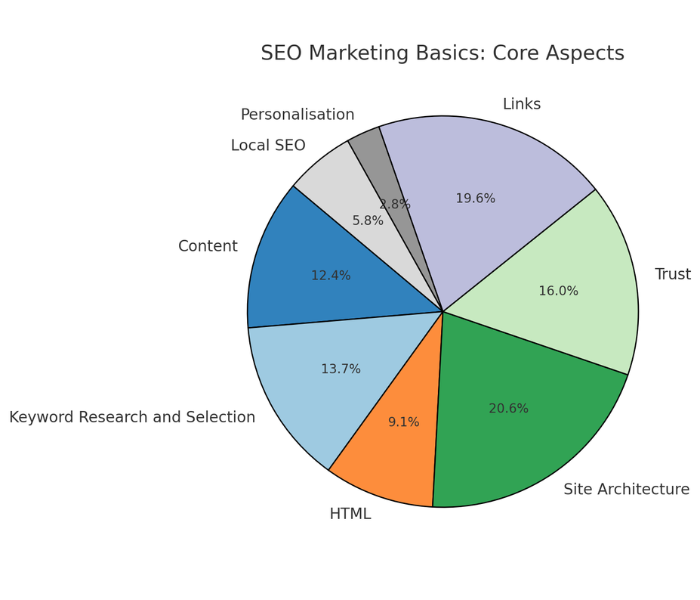
Content: At the heart of SEO lies content—the soulful stories and insights you share. High-quality, relevant, and engaging content is like a heart-to-heart talk with your audience. It involves speaking their language, understanding their joys and struggles, and offering solace, information, or inspiration. When your content resonates with the human experience, it transcends digital barriers and touches lives.
Keyword Research and Selection: Finding the right keywords is akin to choosing the right words in a deep conversation. It’s about understanding what words your audience uses to express their needs and desires. It’s a delicate balance of empathy and insight, ensuring you’re not just heard but understood and appreciated.
HTML: The technical aspects of HTML, such as title tags, meta descriptions, and header tags, are like the subtle cues in a conversation that guide the flow and understanding. They help search engines grasp the context of your content, ensuring that your message is clear, inviting, and compelling.
Site Architecture: A well-structured website is like a home with open doors and comfortable spaces. It invites visitors in, makes them feel welcome, and guides them intuitively through its halls and rooms. When your site architecture speaks of care and thoughtfulness, visitors are more likely to linger and explore.
Trust: Building trust in the digital realm is like nurturing a friendship. It requires consistency, honesty, and transparency. Creating quality content, ensuring the security of your website, and building a clean backlink profile are akin to the gestures of trust in a relationship, laying the foundation for a lasting bond.
Links: The art of linking, both inbound and outbound, is like the art of conversation. It involves not only speaking but also listening and referencing others. It’s about being part of a larger dialogue, contributing to and drawing from the community, and enriching the collective understanding.
Personalisation: Personalizing your SEO efforts is like personalizing a gift. It shows that you understand and value the unique needs and preferences of your audience. This could mean tailoring your approach for different regions, cultures, or interests, showing that you care about the individual behind the search query.
Local SEO: For businesses that are part of a community, local SEO is like being a friendly neighborhood expert. It’s about making your presence known and appreciated in your local area, being a go-to source for local queries, and building a sense of community and belonging.
SEO marketing is more than just techniques and algorithms; it’s about building meaningful connections, understanding human stories, and being a part of the journey of those who seek information, solutions, or a moment of connection in the vast digital world.
SEO Strategies: Black Hat vs. White Hat
In the world of SEO, there exists a tale of two paths: black hat and white hat. These paths, though leading to the same destination of visibility and recognition, are traveled with vastly different intentions and consequences, much like the choices we face in our own lives.
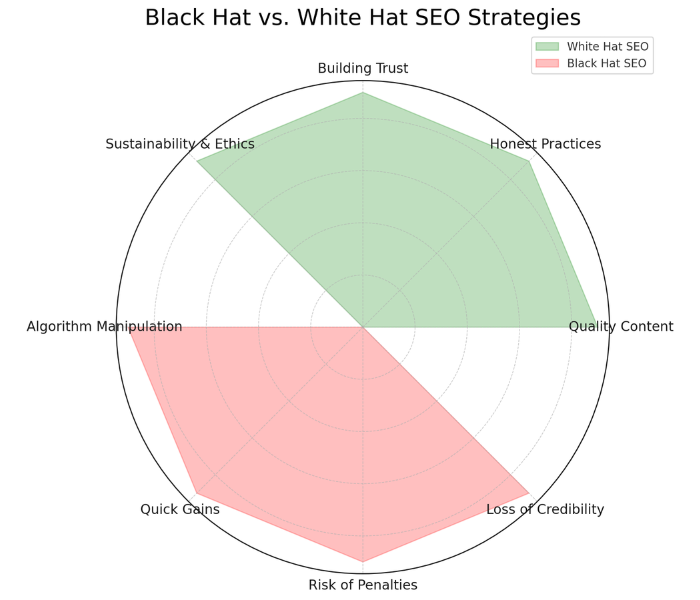
White-hat SEO
This is the path of integrity and sustainability. It’s like nurturing a garden with care and patience, respecting the natural growth process. White-hat SEO involves:
Cultivating quality content that genuinely serves and enlightens your audience is like sharing wisdom with a true heart.
Engaging in honest practices that align with search engine guidelines is akin to living a life of virtue and sincerity.
Building relationships based on trust and respect is much like forming genuine connections in a community.
Choosing White Hat SEO is like choosing a journey filled with honesty and respect, where the rewards are not just immediate but lasting and enriching, building a legacy of trust and value.
Black-hat SEO
This path, shadowed and risky, is like taking shortcuts through the wilderness. Black-hat SEO includes:
Manipulating search engine algorithms through dubious means like keyword stuffing and cloaking is akin to deceiving in conversation.
Seeking quick gains without regard for sustainability or ethics, like chasing success at the cost of one’s values,.
Using tactics that may bring immediate visibility, but at the risk of penalties and loss of trust, is akin to building castles on sand.
The Black Hat path, while tempting with its promise of quick results, often leads to a hollow victory, fraught with risks and the potential for loss of credibility and standing.
In the grand story of SEO, the choice between Black Hat and White Hat is a choice about the kind of legacy you want to build. White-hat SEO, with its focus on ethical practices and genuine value, is like weaving a tale that stands the test of time, earning the respect and trust of your audience. Black-hat SEO, though tempting with its quick fixes, risks the stability and integrity of your presence in the digital world.
How to Monitor and Track SEO Results
Navigating the world of SEO is like embarking on a voyage across a vast ocean. To understand where you are and where you’re headed, monitoring and tracking your progress is essential. This process is akin to charting a course, marking your achievements, and adjusting your sails as needed. Let’s explore this journey with a sense of discovery and attentiveness.
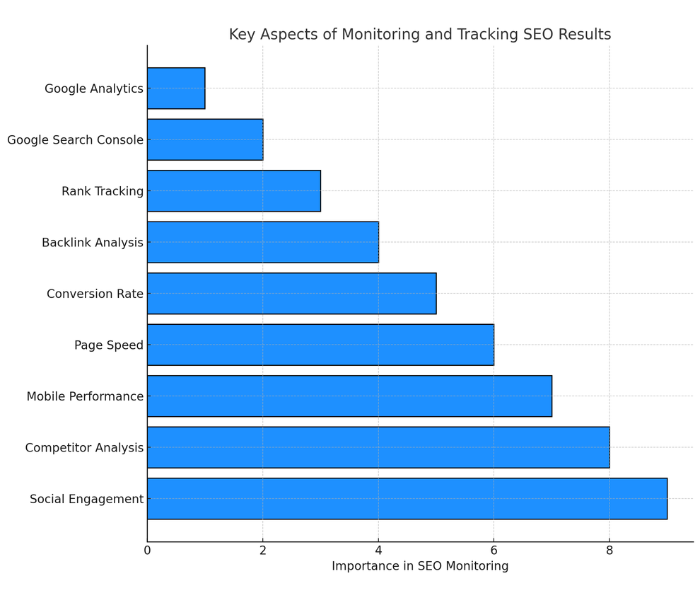
Google Analytics: Imagine this tool as your compass and map, guiding you through the complex waters of website traffic and user behavior. Google Analytics offers a window into the souls of your visitors, revealing their paths through your site, their desires, and their interactions. This tool helps you understand the impact of your content, akin to reading the stars, guiding your future strategies with the wisdom of the past.
Google Search Console: Like a lookout atop the mast, Google Search Console helps you see how Google views your website. It reveals the queries that lead users to you, the health of your site, and areas where you can improve. It’s about understanding the language of the sea and the sky and ensuring that your website is well-tuned to the rhythms of the search.
engine, like a ship ready for smooth sailing.
Rank Tracking: Monitoring your rankings in search results is like charting your progress on a treasure map. Tools like SEMrush, Ahrefs, or Moz act as navigational aids, helping you track the position of your keywords like landmarks on a journey. Watching for shifts in your rankings can reveal the impact of your SEO efforts, much like a captain adjusts the course based on the changing winds and currents.
Backlink Analysis: The backlinks to your website are like the ties you have with other ships on the sea. Tools for backlink analysis let you gauge the strength and quality of these ties, indicating whether you’re seen as a trusted and authoritative vessel in the vast ocean of the internet.
Conversion Rate: Beyond the horizon of traffic lies the land of conversions. Tracking how many visitors take the desired action on your site is crucial. It’s the difference between simply sailing the seas and discovering new lands, turning visitors into settlers, or, in business terms, leads into customers.
Page Speed: Your website’s speed is like the speed of your ship. Tools like Google’s PageSpeed Insights help ensure your vessel is swift and agile, ready to catch the wind. A fast-loading site enhances the user experience, ensuring your crew and passengers remain happy and engaged.
Mobile Performance: With the modern world navigating primarily on mobile devices, ensuring your website’s performance on these devices is like making sure your ship is seaworthy in all kinds of weather. Google’s Mobile-Friendly Test can help you ensure that your site is accessible and user-friendly, no matter the device used to access it.
Competitor Analysis: Understanding the movements and strategies of other ships in the ocean is vital. Tools for competitor analysis provide insights into the SEO strategies of your competitors, helping you learn from their voyages and perhaps discover new routes or avoid potential pitfalls.
Social Engagement: While not a direct ranking factor, social engagement is like the songs and stories shared about your journeys. It reflects how your content resonates with your audience and is shared across social media. Monitoring this engagement can provide valuable insights into your content’s impact and reach.
In the grand voyage of SEO, tracking and monitoring your progress is not just about numbers and charts; it’s about understanding the human element behind the data. It’s a continuous journey of learning, adapting, and connecting with your audience, navigating the ever-changing waters of the digital world with skill and insight.
Conclusion
SEO is more than just algorithms and keywords; it’s an art form that connects us to the digital world. It’s about crafting content that resonates with both search engines and human hearts. This ongoing journey requires us to adapt to new trends and user behaviors, much like a navigator using stars to chart new courses.
At its core, SEO is about building relationships and establishing trust. It’s a commitment to creating a meaningful digital presence that engages and listens. As we move forward, SEO remains a vital part of digital marketing, woven into every word, link, and strategy we create.
Remember, SEO transcends technical aspects, focusing on connecting, understanding, and being understood. It’s a symphony of technology and humanity, harmonizing search engine mechanics with the emotional and intellectual needs of our audience. Our role is to guide each searcher with enlightening content, enriching their digital experience.
Ultimately, the future of SEO is about understanding and connecting with people—a journey of continuous learning and empathy. Let’s embrace this path with passion and creativity, respecting the human experiences that enliven the world of SEO.
